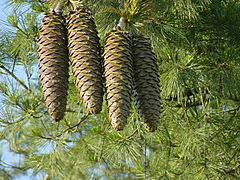Pinus lambertiana
| Sugar Pine | |
|---|---|

| |
| Sugar Pine cones and needles | |
| Scientific classification | |
| Kingdom: | |
| Division: | |
| Class: | |
| Order: | |
| Family: | |
| Genus: | |
| Subgenus: | |
| Species: | P. lambertiana
|
| Binomial name | |
| Pinus lambertiana | |

| |
| Range | |
The Sugar Pine (Pinus lambertiana; family Pinaceae) is a species of pine that occurs in the mountains of Oregon and California in the western United States, and Baja California in northwestern Mexico; specifically the Sierra Nevada, the Cascade Range, the Coast Ranges, and the Sierra San Pedro Martir.
Growth
This tree is the largest species of pine, commonly growing to 40-60 meters (130-200 feet) tall, exceptionally up to 81 m (265 ft) tall, and with a trunk diameter of 1.5-2.5 m (5-8 ft), exceptionally 3.5 m (11 ft).

It is a member of the white pine group, Pinus subgenus Strobus, and like all members of that group, the leaves ('needles') are in fascicles (bundles) of five, with a deciduous sheath. They are 6-11 cm (2-4 inch) long. Sugar Pine is notable for having the longest cones of any conifer, mostly 25-50 cm (10-20 in) long, exceptionally up to 66 cm (26 in) long (although the cones of the Coulter pine are more massive). The seeds are 10-12 mm (0.4-0.5 in) long, with a 2-3 cm (0.75-1.2 in) long wing that aids wind dispersal.
Fungus infection
The Sugar Pine has been severely affected by the White Pine Blister Rust (Cronartium ribicola), a fungus that was accidentally introduced from Europe in 1909. A high proportion of the Sugar Pine has been killed by the blister rust, particularly in the northern part of the species' range that has experienced the rust for a longer period of time. The rust has also destroyed much of the Western White Pine and Whitebark Pine throughout their ranges.[1] The U.S. Forest Service has a program (see link below) for developing rust-resistant Sugar Pine and Western White Pine. Seedlings of these trees have been introduced into the wild. The Sugar Pine Foundation in the Lake Tahoe Basin has been successful in finding resistant sugar pine seed trees and has demonstrated that it is important for private citizens to assist the U.S. Forest Service in restoring this species. [2]
Etymology
Naturalist John Muir considered Sugar Pine to be the "king of the conifers". The name comes from the sweet resin, which Muir found preferable to maple sugar.[3]
Folklore

In the Achumawi creation myth, Annikadel, the creator, makes one of the 'First People' by intentionally dropping a Sugar Pine seed in a place suitable for growth. One of the descendants in this ancestry is Sugarpine-Cone man, who has a handsome son named Ahsoballache.
After Ahsoballache marries the daughter of To'kis the Chipmunk-woman, his grandfather insists that the new couple have a child. To this end, the grandfather breaks open a scale from a Sugar Pine cone, and secretly instructs Ahsoballache to immerse the scale's contents in spring water and hide it inside a covered basket. Ahsoballache performs the tasks that night; at the next dawn, he and his wife discover the infant Edechewe near their bed.
References and external links
- Template:IUCN2006
- US Forestry Service: Pinus lambertiana
- Arboretum de Villardebelle: photo of a cone
- Gymnosperm Database: Pinus lambertiana
- Flora of North America: Pinus lambertiana
- US Forest Service, Dorena Genetic Resource Center (rust resistance program)
- The Sugar Pine Foundation (Sugar Pine and Western White Pine Restoration Program)
- Muir, J. (1911). My First Summer in the Sierra.

